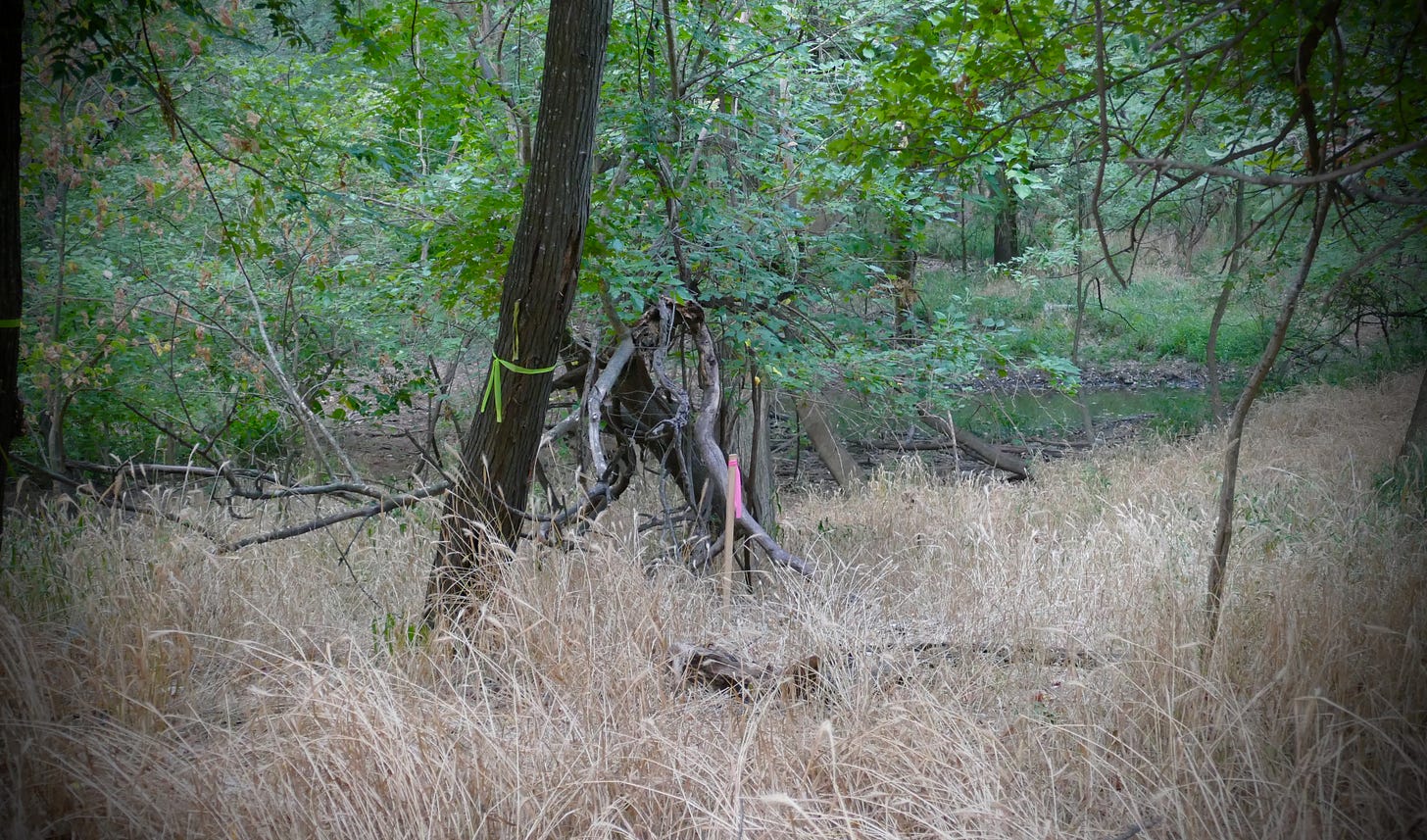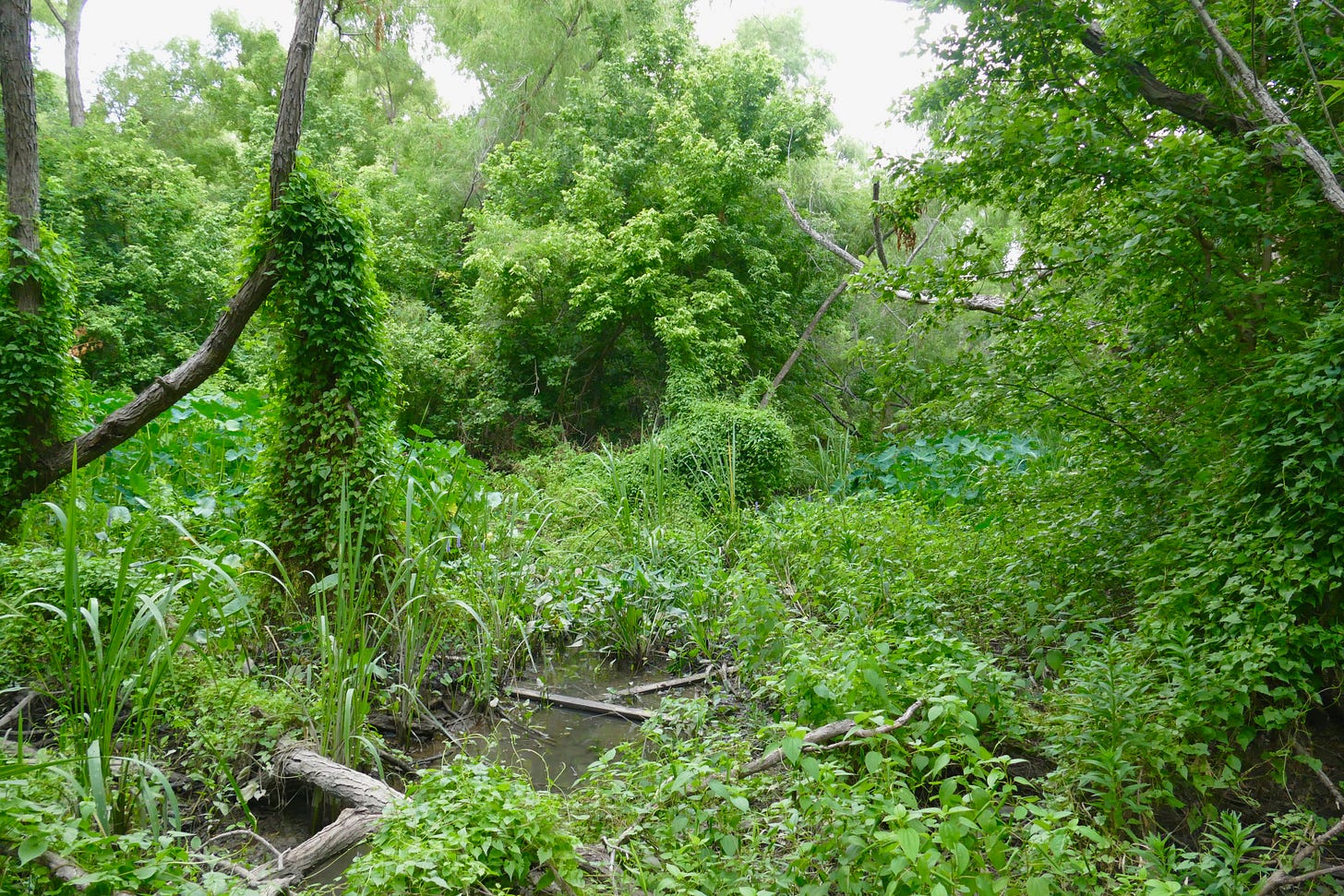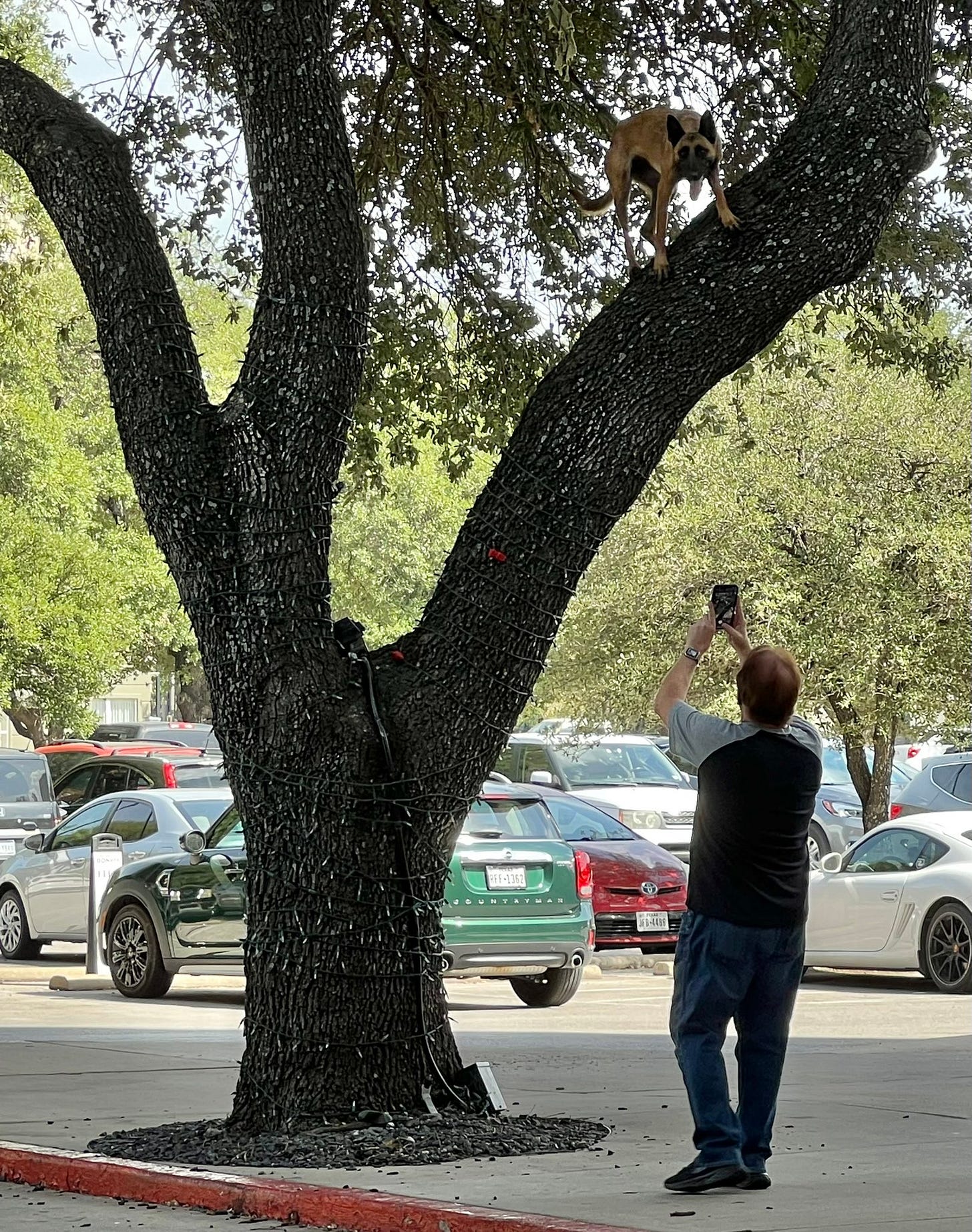Some August auspices
Wednesday morning the edgeland cur and I set out at daybreak for a walk through the feral zone behind the industrial park. Agents of the limited liability company that owns the lot next door to us had spent the week before mowing the tall grass and then cutting up and grinding down all the fallen trees that had turned that field behind the door factory into a bushwhacker’s labyrinth. Seeing it so suddenly cleaned up and walkable, you couldn’t help but wonder whether it is being readied for sale. Riverfront property, with a view of the end of the world.
A couple of weeks before, I had helped a man lost in that labyrinth find his way out. The dude had walked up out of the river, as if on cue for the documentary filmmakers I was hosting, wearing long pants and socks but no shoes, sopping wet from head to toe, seemingly amped up on Spice, accompanied by an intact male pit bull that looked even more confused than him. When I offered to unlock the gate he ignored me and proceeded to get down on the ground and squeeze through the fox-sized aperture in the patch of hog panel at the base, shaved head first, with the implausible plasticity of that rubber man Scully and Mulder once pursued. Then he stood up, shaked it off, yelled at his dog, and shambled on into the concrete jungle.
The field guides that help you identify things you find in the woods don’t explain those brightly-colored ribbons the surveyors leave behind. Real estate capital operates mostly in the etheric realm of words and numbers on paper, and the ephemeral marks it makes on the land are not really legible without the maps whose abstracted marks they anchor. But whenever they appear, you can feel the gaze that projected them, imagining ways to turn the land into money. You remember the grade school lesson that George Washington made his name first as a land surveyor, enabling the carving up of the American wilderness into lots one could buy and sell.
I had seen survey crews out the week before. A total station theodolite there on the loop road, left by the crew that had parked their truck at the entrance to the run-down preserve beneath the tollway bridge. When you see them taking fresh readings of the metes and bound of public land, you can’t help but wonder what changes in the use of that land are being considered. It’s only in the past few decades that these acres of exurban floodplain have been allowed to go back to wild, inadvertently protected by the industrial land uses that hide them from the street.
Lupe and I followed the right of way of the old ferry road back through there, a sliver of public property that is mostly used by urban canids to travel between the woods and the city. Toward its end, we picked up a side trail where the summer deer have worn a path along the creek that flows from the culvert behind the construction supply warehouse. Then we worked our way back up the bluff and through a stand of young retama that opened up onto the big flat field behind the dairy plant. It had been recently mowed as well, the truncated stalks of the Johnson grass gone brown. A mockingbird perched on the resilient little branch of a young mesquite that had survived being run over by the big mower.
Looking at the picture later, I got to wondering what more diverse flora and fauna would have occupied that ancient alluvial floodplain when it was still part of the Blackland prairie that once stretched from Dallas to San Antonio. Ninety-nine percent of that ecosystem has been erased by the plow and the bulldozer, even as the possibility of its return is always lurking in the wildflowers that pop up along the roadside and the grasses that grow where the mowers don’t go.
On the other side of the fence, a dude from the dairy plant eyed us as he wrangled the milk trailers lined up in the overflow lot, sizing me up with the same wariness I give the guys I encounter coming up out of the woods. The fences that protect the industrial facilities from the wild were covered in green, and the tall poles that carry telecom traffic through the right of way at the speed of light were so completely overtaken by live vines that you could see a near future in which they take down the Internet. I wondered if they might be able to replace it.
On the other side of that man-made plain, there’s a little zone where the invasive cane grows thick between the woods of the preserve, the mowed area behind the plant, and the loop road that curves under the tollway bridge. It’s a popular area to camp for those who find themselves living outside, where they can hide in plain sight behind the shelter of that tall but easily cut vegetation, yet be a few steps from the sidewalk to town. This summer a lot more folks seem to have moved in there. Some of them even have cars that they park along the road, while others have begun to build more permanent shelters with the lumber they harvest from the preserve and tarps they make from the trash they find.
I wonder how many of them might qualify as climate refugees, if you knew their story. And I wonder how much time they have before the rangers come through and tell them they need to move on. You can bet some of them have jobs, even as they have to live like nomads. Nomads navigating their way through the triple-digit hellscape we made, pitching camp for a few weeks in what shade they can find before they have to head to the next place. Early adopters, perhaps, of the future we have made for ourselves.
As we walked along the edge of that site, a red-shouldered hawk flew past the dead windsock above the giant tanks of cow milk, mobbed by some of the starlings that nest behind the nearby billboards for cash-back debit cards and personal injury lawyers.
Down behind the camps, even the prickly pear looked under-watered after two months with almost no rain. The wild rye and the inland sea oats that had greened up the forest floor in springtime were dried out and done, and their seeds mostly spread for fall, when hopefully the skies will open up again. The woods seemed a little dead, other than a pair of young deer foraging in the grove left behind by a long-abandoned county road.
When we got to the spot where the trail crosses the creek, the water was too high cross without getting wet, and the dam-released river water that filled up the channel looked too nasty to wade through. So we bushwhacked our way further up, looking for an easier spot. And stumbled upon a secret swamp, right past an abandoned throne of the Texas Druid King.
The swamp was made by the unnatural cycles of scheduled releases from the dam upriver, the main purpose of which is to support rice farming near the coast. Wet during the morning hours, but then dry in the afternoon and evening, providing what must be an elusive habitat for amphibian life. The water feeding that green doesn’t look like water you would want to drink yourself. And if you look closely, you will see the trash, some of it washed down the creeks from the streets above, some brought by the river during the last flood. Those qualifications of its beauty didn’t make that pocket of green any less wondrous or reassuring a thing to find.
We found our way through, stopping to admire the shaded blooms of purple and red. On the other side, we found ourselves under the tall cottonwoods of the floodplain, littered with desiccated trash and treefall. As we walked, sphinx moths lifted off from the trunks on which they had rested at daybreak, like dusty fairies annoyed at having their sleep interrupted. When we looked back down, we saw what looked to be three active coyote dens at our feet. No one came out to greet us, but we were glad to have found some more signs of life, at the peak of the season when you can’t help but wonder if there’s much left.
Saturday evening my daughter and I heard thunder in the skies above. It had been acting like it wanted to rain all day. And then it finally did, just as our neighbors were arriving to join us for dinner. We felt it on our faces and hands, smiling. More than a drizzle, but not much. After about three minutes, it stopped, and we never got more.
Sometimes I wonder when we will go back to ritual sacrifices designed to appease the elements through sympathetic magic. As we begin to glimpse the nightmare our vaunted reason has conjured, you can sense the dead gods that terrified our ancestors lurking offstage, getting ready to correct our hubris, and maybe even our dominion.
Extra credit
Wednesday afternoon my wife texted me to report that the authorities were evicting the folks who had been living in the old motor court apartments at the far end of our block. The property, which I have been reporting on here over the season, has been without utility service for the past couple of years, since the owner apparently stopped paying her property taxes. Just the day before while driving my daughter to school, I had seen one of the tenants headed out on his bike to fill two huge jugs from the hose outside the C-store. Shirtless and already sweaty at the beginning of the day, as you would be if you had to endure a Texas summer without a/c. The next morning, I walked by to take a closer look at what was left behind in the complex whose windows had been abruptly boarded up. A wall turned into a mantle, a beautiful mosaic cross, a firepit in the middle of a communal courtyard, a plastic box of love letters whose postmarks revealed that the mail was still delivered long after the power and water went out. The only paraphernalia in sight was another empty can of Freedom, offered up at the altar of a dead television by the side of the road.
The sense that the way those folks were living was a glimpse into one thread of the American future was affirmed by the report in this week’s New York Times about the water shortage across the border in Monterrey—a vision of urban life when the water needed to support the population really starts to run out.
At The Verge, an amazing report on the virtual border wall that uses some of the world’s most advanced nets of electronic surveillance to prevent those who would cross over in search of wetter climes. Thanks to Bruce Sterling for the link.
And I was delighted to see the Times’ coverage this week of Austin writer Gabino Iglesias, who I have been lucky to get to know in recent years. Gabino writes journalism, criticism, and an energetic fiction he calls “barrio noir”—intense crime stories with elements of the fantastic that fearlessly break the rules of genre and language in a way that captures the real voice of the borderzone.
In the latest issue of The New Yorker (August 8), I appreciated this intense poem by Joy Harjo, “An Ordinary Morning,” which captures some of the extreme facets of the human relationship with nature in a couple dozen lines. Looking it up in the online version of the magazine I still get in print, I’m pleased to see you can also hear it read by the author.
This weekend I am at Armadillocon, Austin’s longstanding conference of imaginative literature (aka a sci-fi convention). If you’re also there, this Sunday morning at 11:30 I’ll be reading an excerpt from a work-in-progress that tries to do what I do in this newsletter at book length. I hope to see some of you there.
In case you’re wondering, in Texas the science fiction conventions come with Chupacabra at the hotel door:
I’d heard of tree-climbing dogs before, but never seen one.
Have a safe week, and stay cool.












